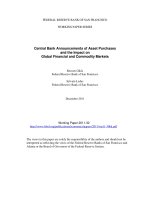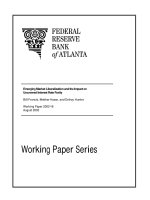Financial accounting the impact on decision makers 9e chapter 6
Bạn đang xem bản rút gọn của tài liệu. Xem và tải ngay bản đầy đủ của tài liệu tại đây (1.47 MB, 40 trang )
Chapter 6
Cash and Internal Control
Cash
Cash:
Readily
available to pay debts
Various forms of
cash:
Coin and
currency on hand
Cash on deposit in the form of checking and savings
accounts
Undeposited, cashier, and certified checks
LO 1
Cash Equivalents
Investment
readily convertible to known
amount of cash
Maturity—three
months or less
Example:
Commercial paper
Treasury
bills issued by the federal government
Money market funds
Six-month
bank certificate of deposit would not
be a cash equivalent
Exhibit 6.1—Cash and Cash Equivalents on the
Balance Sheet and the Statement of Cash Flows
Cash Management
Tools of
cash management:
Cash
flows statement
Cash budgets
Bank reconciliations
Petty cash funds
LO 2
Reading a Bank Statement
Bank statement
: a detailed list, provided by the
bank, of all activity for a particular account
during the month.
Outstanding check : check written by a
company but not yet presented to the bank for
payment
Deposit in transit : deposit recorded on the
books but not yet reflected on the bank
statement
Bank Reconciliation
Reconcile
or resolve any differences between
balance on the bank statement with balance
shown in the accounting records
Steps used in preparing a bank reconciliation:
1.
2.
3.
4.
5.
Prepare a list of the deposits in transit
Prepare a list of the outstanding checks
Prepare a list of credit memoranda
Prepare a list of debit memoranda
Identify any errors
Credit Memoranda and Debit
Memoranda
Credit memoranda
Additions
on a bank statement for such items as
interest paid on the account and notes collected by
the bank for the customer
Debit
memoranda
Deductions
on a bank statement for items such as
NSF checks and various service charges
Step 1: Prepare a list of the
deposits in transit
Trace
deposits listed on the bank statement to
the books
Identify the deposits in transit
Any
deposits recorded on the books but not yet
shown on the bank statement
Add
to the bank balance
Step 2: Prepare a List of the
Outstanding Checks
Arrange
the canceled checks in numerical order
Trace each of them to the books
Any
checks recorded on the books but not yet listed
on the bank statement are outstanding
Subtract
from the bank balance
Step 3: Prepare a List of Credit
Memoranda
List all
items, other than deposits, shown as
additions on the bank statement
Interest
paid by the bank
Amounts collected by the bank for the customer
For these
items, bank increases, or credits, its
liability to the company on its own books
Step 4: Prepare a List of Debit
Memoranda
List all
amounts, other than canceled checks,
shown as subtractions on the bank statement
NSF
checks
Service charges
A
liability is created on the books of the bank
when a company deposits money in a bank
Bank reduces the amount of its liability for
these various items and debits the liability on its
own books
Step 5: Identify any Errors
Identify
any errors made by the bank or by the
company in recording cash transactions
Bank Reconciliation
Bank Reconciliation
Balance per bank
$$$
Adjusted balance
$$$
Balance per books
$$$
Adjusted balance
$$$
Example 6.2—Preparing a Bank
Reconciliation
Need for Adjustments to the Records
Book
adjustments
are basis for
adjusting
entries
Petty Cash fund
Money
kept on hand for making minor
disbursements rather than by writing checks
Periodically, the fund is replenished
When fund is replenished, an adjustment is
made to record its replenishment and to
recognize the various expenses incurred
Internal Control System
Policies
and procedures necessary to ensure:
Safeguarding
of an entity’s assets
Reliability of accounting records
Accomplishment of overall company objectives
LO 3
Sarbanes-Oxley Act of 2002—SOX
An
act of Congress in 2002
Intended to bring reform to corporate
accountability and stewardship in the wake of a
number of major corporate scandals
Sarbanes-Oxley Act of 2002—SOX
(continued)
Internal control report: a
report required by
Section 404 of the Sarbanes-Oxley Act
Maintain an adequate
internal control structure
Assesses effectiveness of internal control structure
Outside
auditors must issue report on
company’s internal control
Sarbanes-Oxley Act of 2002—SOX
(continued)
Public Company
Accounting Oversight Board
(PCAOB): five-member body created by SOX
Set
auditing standards in the United States
Board
of directors: consists of key officers of a
corporation and outside members responsible
for general oversight of the affairs of the entity
Audit committee: a subset of the board of
directors
Provides
direct contact between the stockholders
and the independent accounting firm
The Control Environment
Factors
that influence internal control:
Management’s
competence and operating style
Personnel policies and practices
Board of directors, particularly audit committee
The Accounting System
Methods
and records used to accurately report
entity’s transactions and maintain
accountability for assets and liabilities
Use of a journal is an integral part of all
accounting systems
Can be completely manual, fully computerized,
or a mixture of both
Internal Control Procedures
Administrative
controls:
Procedures
concerned with efficient operation of
the business and adherence to managerial policies
Accounting
controls:
Procedures
concerned with safeguarding the assets
or the reliability of the financial statements
LO 4
Internal Control System
Important internal control procedures:
Proper
authorizations
Segregation of duties
Independent verification
Safeguarding of assets and records
Independent review and appraisal
Design and use of business documents









